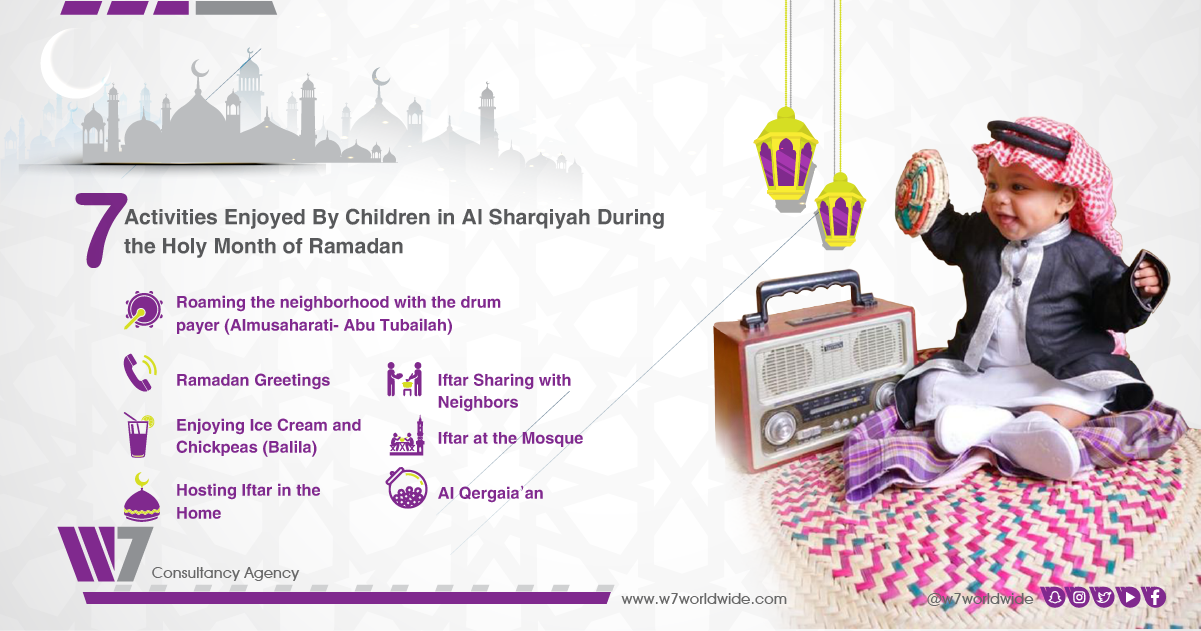Ramadan is a month of connection, reflection and mindfulness. It is known to bring together families, neighbors and friends. It is an icon of tolerance, love, and generosity. It is also a month of getting closer to God and doing good to His creation. Traditionally Muslim families come together to share meals, pray together and rekindle family ties.
There are a couple of traditions that children and families of Al Sharqiyah enjoy and practice to usher in the holy month. The Ramadan traditions in Al Sharqiyah are most similar those in Kuwait and the Kingdom of Bahrain, and some of the key activities the children practice are:
1) Roaming the neighborhood with the drum payer (Almusaharati- Abu Tubailah)
Picture a beautiful setting where the children gather around the drum player right before sunrise, calling out in a loud clear voice to wake the neighborhood for the suhoor meal. This tradition remains until today despite the availability of modern communication methods.
2) Ramadan greetings
Ramadan memories to children in Al Sharqiyah, often form around gathering around the iftar table, and visiting family members and neighbors. Prayers of accepted worship and charitable activities are also encouraged and carried on year after year.
3) Enjoying fruit juice popsicles and Chickpeas (balila)
The month of Ramadan is observed around the summer months in the Arab world. The days are usually especially hot and to cool down, people usually freeze tens of watered-down berry juice such as (Vimto) in plastic bags daily. They also enjoy a chickpea snack (balila) after the evening taraweeh prayer when the temperature has cooled down. In the evening children usually relish ice cold popsicles sold at nominal prices. This has been an ongoing tradition in the streets of Al Sharqiyah especially in neighborhoods and near mosques.
4) Al Qergaia’an
A colorful social celebration where children adorn themselves in traditional clothing and walk around chanting songs asking for the goods that the neighbors will give them. Sweets and nuts are usually distributed to children during this celebration, and families arrange for musical bands with drums that welcome the children by singing and chanting songs incorporating their names wishing them well. Some families will also hire a horse and a carriage for the children to experience how this occasion was celebrated in the old days.
5) Iftar at the Mosque
In a beautiful expression of good, and seeking reward from God during the holy month, of Ramadan Mosques usually host iftars for the community of Muslims and non-Muslims to come together and share a meal and connect with one another. Families usually contribute to this practice by sending homemade dishes with the children to share with the community at large. This practice is not exclusive to this area and is also practiced regionally and globally among Muslim minorities as well. It is one of the most sought after and loved practices in the month of giving.
6) Sharing iftar with neighbors
Social ties are usually rekindled and strengthen during the month of Ramadan. Neighbors come together and share their traditional dishes. Children enjoy this practice as they get reacquainted with their neighbors and get to try a variety of delicious Ramadan delicacies.
7) Hosting iftar in the home
Families during the month of Ramadan sometimes circulate hosting iftars in the homes of the grandparents, siblings, aunts and uncles. This encourages more engagement and connection between family members especially children, where a specific household or several could host iftar daily, weekly or in any frequency. Young and old, come together to share and contribute to these iftars. They prepare delicious dishes, tea and coffee shared by all.
These are the seven traditions in Al Sharqiyah that create an unforgettable experience during the holy month of Ramadan. You will thoroughly appreciate your visit to Al Sharqiyah during the month of blessings, and try the delicacies that children enjoy in the holy month.
Have you experienced any of these traditions in your community?








